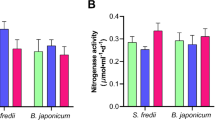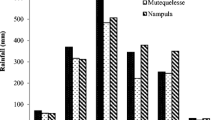Abstract
A 3 × 2 × 2 factorial field experiment, organized in a randomized complete block split-plot with four replications, was conducted in 1994 to evaluate the effect of two plant growth-promoting rhizobacteria (PGPR) strains (Serratia liquefaciens 2-68 or Serratia proteamaculans 1-102) on nodulation, nitrogen fixation, and total nitrogen yield by two soybean cultivars in a short season area. The experiments were conducted at the Emile A. Lods Research Centre, McGill University, Macdonald Campus, Montreal, Canada, and performed at two adjacent sites. One site was fumigated with methyl bromide (50 g m-2). Another site was kept unfumigated. Co-inoculation of soybean with B. japonicum and PGPR increased soybean nodulation and hastened the onset of nitrogen fixation, when the soils were still cool. Total fixed N, fixed N as a percentage of total plant N, and protein and N yield were also increased by PGPR inoculation. AC Bravor tended to be more responsive to both PGPR treatments for total fixed N and N yields than Maple Glen, suggesting that inoculation with PGPR was more effective for cultivars with higher yield potentials.
Similar content being viewed by others
References
Alagawadi A R and Gaur A C 1992 Inoculation of Azospirillum brasilense and phosphate-solubilizing bacteria on yield of sorghum [Sorghum bicolor (L.) Moench] in dry land. Trop. Agric. 69, 347–350.
Backman P A and Turner J T Jr 1989 Plant response and disease control following seed inoculation with Bacillus subtilis. In Proceedings of the Beltwide Cotton Products Research Conference [Book 2]. Ed. J M Brown. pp 61–71. National Cotton Council of America, Memphis.
Bashan Y and Holguin G 1997 Azospirillum — plant relationships: environmental and physiological advances (1990–1996). Can. J. Microbiol. 43, 103–121.
Bhuvaneswari T V, Goodman R N and Bauer W D 1980 Early events in the infection of soybean (Glycine max L. Merr.) by Rhizobium japonicum. I. Location of infectible root cells. Plant Physiol. 66, 1027–1031.
Chanway C P, Hynes R K and Nelson L M 1989 Plant growth-promoting rhizobacteria: effects on growth and nitrogen fixation of lentil (Lens esculenta Moench) and pea (Pisum sativum L.). Soil Biol. Biochem. 21, 511–517.
Dashti N, Zhang F, Hynes R K and Smith D L 1997 Application of plant growth-promoting rhizobacteria to soybean (Glycine max [L.] Merr.) increases protein and dry matter yield under short-season conditions. Plant Soil 188, 33–41.
Del Gallo M and Fabbri P 1990 Inoculation of Azospirillum brasilense Cd on chickpea (Cicer arietinum). Symbiosis 9, 283–287.
De-Ming L I and Alexander M 1988 Co-inoculation with antibiotic producing bacteria to increase colonization and nodulation by rhizobia. Plant Soil 108, 211–219.
de Freitas J R and Germida J J 1990 Plant growth promoting rhizobacteria for winter wheat. Can. J. Microbiol. 36, 265–272.
Fehr W R, Caviness C E, Burmood D T and Pennington J S 1971 Stages of development descriptions for soybeans, Glycine max (L.) Merrill. Crop Sci. 11, 929–930.
Fulchieri M and Frioni L 1994 Azospirillum inoculation on maize (Zea mays): effect on yield in a field experiment in central Argentina. Soil Biol. Biochem. 26, 921–923.
Gaskins M H, Albrecht S L and Hubbel D H 1985 Rhizosphere bacteria and their use to increase productivity: a review. Agric. Ecosys. Environ. 12, 99–116.
Greenough D R and Batson W E 1989 Potential for Bacillus subtilis as a bioprotectant of cotton seedlings in soil infested with Rhizoctonia solani. Phytopathol. 79, 373.
Grimes H D and Mount M S 1987 Influence of Pseudomonas putida on nodulation of Phaseolus vulgaris. Soil Biol. Biochem. 16, 27–30.
Hardy R W, Holstein W F, Jackson E K and Burns R C 1968 The acetylene-ethylene assay for N2 fixation: laboratory and field evaluation. Plant Physiol. 43, 1185–1207.
Hume D J and Shelp B J 1990 Superior performance of the hup- Bradyrhizobium japonicum strains 532C in Ontario soybean field trials. Can. J. Plant Sci. 70, 661–666.
Jones F R and Tisdale W B 1921 Effect of soil temperature upon the development of nodules on the roots of certain legumes. J. Agric. Res. 22, 17–37.
Kloepper J W, Schroth M N and Miller T D 1980 Effects of rhizosphere colonization by plant growth promoting rhizobacteria on potato plant development and yield. Phytopathol. 70, 1078–1082.
Kloepper J W, Scher F M, Laliberte M and Tipping B 1986 Emergence-promoting bacteria: Description and implications for agriculture. In Iron, Siderphores and Plant Diseases. Ed. T R Swinburne. pp 155–164. Plenum, New York.
Lynch D H and Smith D L 1993 Soybean [Glycine max (L.) Merr.] nodulation and N2 fixation as affected by period of exposure to a low root zone temperature. Physiol. Plant. 88, 212–220.
Polonenko D R, Scher F M, Kloepper J W, Singleton C A, Laliberte M and Zaleska I 1987 Effects of root colonizing bacteria on nodulation of soybean roots by Bradyrhizobium japonicum. Can. J. Microbiol. 33, 498–503.
Preston C M, Preston J M and Callway E G 1981 Inexpensive 15N analysis of agricultural samples by optical emission spectroscopy employing a simple, one-step Dumas sample preparation procedure. Can. J. Spectro. 26, 239–244.
Sarig S, Okon Y and Blum A 1990 Promoting of leaf area development and yield in Sorghum bicolor inoculated with Azospirillum brasilense. Symbiosis 9, 235–245.
SAS Institute Inc. 1988. SAS User's Guide. Cary, North Carolina: Statistical Analysis Institute Inc.
Sprent J I 1979 The Biology of Nitrogen Fixation Organisms. Chapman and Hall, New York.
Sprent J I and Sprent P 1990 Nitrogen Fixing Organisms. Chapman and Hall, New York.
Steel R G D and Torrie J H 1980 Principles and Procedures of Statistics: A Biometric Approach. McGraw-Hill, New York.
Turner J T and Mackman P A 1991 Factors relating to peanut yield increases following Bacillus subtilis seed treatment. Plant Disease 75, 347–353.
Vincent J M 1970 A Manual for the Practical Study of Root Nodule Bacteria. Oxford: Blackwell Scientific Publication, Oxford.
Whigham D K and Minor H C 1978 Agronomic characteristics and environmental stress. In Soybean Physiology, Agronomy, and Utilization. Ed. G A Norman. pp 77–118. Academic Press, New York.
Zhang F and Smith D L 1994 Effects of low root zone temperature on the early stages of symbiosis establishment between soybean [Glycine max.(L) Merr.] and Bradyrhizobium japonicum. J. Exp. Bot. 279, 1467–1473.
Zhang F, Dashti N, Hynes R K and Smith D L 1996 Plant growth promoting rhizobacteria and soybean (Glycine max L. Merr.) nodulation and nitrogen fixation at suboptimal root zone temperatures. Ann. Bot. 77, 453–459.
Zhang F, Dashti N, Hynes R K and Smith D L 1997 Plant growth promoting rhizobateria and soybean (Glycine max L. Merr.) growth and physiology at suboptimal root zone temperatures. Ann. Bot. 79, 243–249.
Author information
Authors and Affiliations
Rights and permissions
About this article
Cite this article
Dashti, N., Zhang, F., Hynes, R. et al. Plant growth promoting rhizobacteria accelerate nodulation and increase nitrogen fixation activity by field grown soybean [Glycine max (L.) Merr.] under short season conditions. Plant and Soil 200, 205–213 (1998). https://doi.org/10.1023/A:1004358100856
Issue Date:
DOI: https://doi.org/10.1023/A:1004358100856




